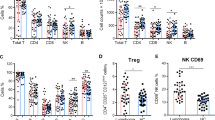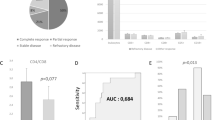Abstract
Lymphocytes play crucial roles in tumor surveillance in diffuse large B-cell lymphoma (DLBCL). Neutrophil-to-lymphocyte ratio (NLR), a biomarker for systematic inflammation, has been confirmed to be a prognostic factor for many malignant diseases. Herein, we conducted a systemic in-depth study of circulating neutrophils and lymphocyte subsets in DLBCL patients and their dynamics along with chemoimmunotherapy. A total of 61 patients with DLBCL were enrolled. Detection of lymphocyte subsets by flow cytometry was conducted at diagnosis and after 2/4/6/8 cycles’ treatment of R-CHOP. Clinical significance, including incidence of infection, curative effect and disease-free survival (DFS), was analyzed based on the patients’ clinical data and the quantity of lymphocyte subsets. The absolute numbers of neutrophils in stage III-IV DLBCL patients were obviously increased (p = 0.012), while the absolute numbers of lymphocytes were decreased (p = 0.025). Consequently, DLBCL patients had significantly higher NLR than healthy controls (p < 0.001). Further analysis of lymphocyte subsets showed a significantly reduced CD4 + T cells in DLBCL patients (p = 0.001). Patients with a lower lymphocyte counts (< 1.26*10E9/L) were more susceptible to infection (p < 0.001). NK cells were much higher in patients achieving complete remission than those of non-complete remission (p = 0.032). Higher neutrophils and NLR were closely associated with poorer DFS (p = 0.001 and p = 0.045, respectively). Circulating cells in DLBCL patients were dysregulated, featured with increased neutrophils and reduced lymphocytes. Higher NK cells before treatment predicted better therapeutic outcome. Higher neutrophils and NLR can be regarded as inferior prognostic predictors for DLBCL patients at diagnosis.




Similar content being viewed by others
Availability of data and material
The data that support the findings of this study are available from the corresponding author, W. Y., upon reasonable request.
Change history
13 September 2022
A Correction to this paper has been published: https://doi.org/10.1007/s10238-022-00881-6
References
Küppers R, Klein U, Hansmann ML, Rajewsky K. Cellular origin of human B-cell lymphomas. N Engl J Med. 1999;341:1520–9.
Martelli M, Ferreri AJ, Agostinelli C, Di Rocco A, Pfreundschuh M, Pileri SA. Diffuse large B-cell lymphoma. Crit Rev Oncol Hematol. 2013;87:146–71.
Sehn LH, Gascoyne RD. Diffuse large B-cell lymphoma: optimizing outcome in the context of clinical and biologic heterogeneity. Blood. 2015;125:22–32.
International Non-Hodgkin’s Lymphoma Prognostic Factors Project. A predictive model for aggressive non-Hodgkin’s lymphoma. N Engl J Med. 1993;329:987–94.
Friedberg JW. New strategies in diffuse large B-cell lymphoma: translating findings from gene expression analyses into clinical practice. Clin Cancer Res. 2011;17:6112–7.
Rosenwald A, Wright G, Chan WC, et al. The use of molecular profiling to predict survival after chemotherapy for diffuse large-B-cell lymphoma. N Engl J Med. 2002;346:1937–47.
Coussens LM, Werb Z. Inflammation and cancer. Nature. 2002;420:860–7.
Pichler M, Hutterer GC, Stoeckigt C, et al. Validation of the pre-treatment neutrophil-lymphocyte ratio as a prognostic factor in a large European cohort of renal cell carcinoma patients. Br J Cancer. 2013;108:901–7.
Mohri Y, Tanaka K, Ohi M, Yokoe T, Miki C, Kusunoki M. Prognostic significance of host- and tumor-related factors in patients with gastric cancer. World J Surg. 2010;34:285–90.
Jung MR, Park YK, Jeong O, Seon JW, Ryu SY, Kim DY. Elevated preoperative neutrophil to lymphocyte ratio predicts poor survival following resection in late stage gastric cancer. J Surg Oncol. 2011;104:504–10.
Wang J, Zhou X, Liu Y, Li Z, Li X. Prognostic significance of neutrophil-to-lymphocyte ratio in diffuse large B-cell lymphoma: a meta-analysis. PLoS ONE. 2017;12: e0176008.
Porrata LF, Ristow K, Habermann T, Inwards DJ, Micallef IN, Markovic SN. Predicting survival for diffuse large B-cell lymphoma patients using baseline neutrophil/lymphocyte ratio. Am J Hematol. 2010;85:896–9.
Keam B, Ha H, Kim TM, Jeon YK, Lee SH, Kim DW. Neutrophil to lymphocyte ratio improves prognostic prediction of International Prognostic Index for patients with diffuse large B-cell lymphoma treated with rituximab, cyclophosphamide, doxorubicin, vincristine and prednisone. Leuk Lymphoma. 2015;56:2032–8.
Ho CL, Lu CS, Chen JH, Chen YG, Huang TC, Wu YY. Neutrophil/lymphocyte ratio, lymphocyte/monocyte ratio, and absolute lymphocyte count/absolute monocyte count prognostic score in diffuse large B-cell lymphoma: useful prognostic tools in the rituximab era. Medicine. 2015;94: e993.
Troppan K, Deutsch A, Gerger A, et al. The derived neutrophil to lymphocyte ratio is an independent prognostic factor in patients with diffuse large B-cell lymphoma. Br J Cancer. 2014;110:369–74.
Rambaldi A, Boschini C, Gritti G, et al. The lymphocyte to monocyte ratio improves the IPI-risk definition of diffuse large B-cell lymphoma when rituximab is added to chemotherapy. Am J Hematol. 2013;88:1062–7.
Ni J, Wang YQ, Zhang YP, et al. Value of neutrophil/lymphocyte ratio and platelet/lymphocyte ratio for prognostic evaluation of diffuse large b-cell lymphoma. Zhongguo Shi Yan Xue Ye Xue Za Zhi. 2016;24:427–32.
Kusano Y, Yokoyama M, Terui Y, et al. Low absolute peripheral blood CD4+ T-cell count predicts poor prognosis in R-CHOP-treated patients with diffuse large B-cell lymphoma. Blood Cancer J. 2017;7: e561.
Battella S, Cox MC, La Scaleia R, et al. Peripheral blood T cell alterations in newly diagnosed diffuse large B cell lymphoma patients and their long-term dynamics upon rituximab-based chemoimmunotherapy. Cancer Immunol Immunother. 2017;66:1295–306.
Ladányi A, Tímár J. Immunologic and immunogenomic aspects of tumor progression. Semin Cancer Biol. 2020;60:249–61.
Saleh R, Elkord E. Acquired resistance to cancer immunotherapy: role of tumor-mediated immunosuppression. Semin Cancer Biol. 2020;65:13–27.
Horne ZD, Jack R, Gray ZT, et al. Increased levels of tumor-infiltrating lymphocytes are associated with improved recurrence-free survival in stage 1A non-small-cell lung cancer. J Surg Res. 2011;171:1–5.
Proctor MJ, Morrison DS, Talwar D, et al. A comparison of inflammation-based prognostic scores in patients with cancer. A Glasgow inflammation outcome study. Eur J Cancer. 2011;47:2633–41.
Mu S, Ai L, Fan F, Qin Y, Sun C, Hu Y. Prognostic role of neutrophil-to-lymphocyte ratio in diffuse large B cell lymphoma patients: an updated dose-response meta-analysis. Cancer Cell Int. 2018;18:119.
Glennie MJ, French RR, Cragg MS, Taylor RP. Mechanisms of killing by anti-CD20 monoclonal antibodies. Mol Immunol. 2007;44:3823–37.
Wang SY, Veeramani S, Racila E, et al. Depletion of the C3 component of complement enhances the ability of rituximab-coated target cells to activate human NK cells and improves the efficacy of monoclonal antibody therapy in an in vivo model. Blood. 2009;114:5322–30.
Abès R, Gélizé E, Fridman WH, Teillaud JL. Long-lasting antitumor protection by anti-CD20 antibody through cellular immune response. Blood. 2010;116:926–34.
Acknowledgements
The authors would like to thank all of the doctors and nurses in the Department of Hematology and the Department of International Medicine, and the researcher team of Clinical Laboratory Centre for their professional assistance.
Funding
The authors have no funding to report.
Author information
Authors and Affiliations
Contributions
WY designed the project. ZY conducted the experiment and analyzed the data. ZY and WY drafted the manuscript.
Corresponding author
Ethics declarations
Conflict of interest
The authors report no conflict of interest.
Ethical approval
This study was approved by the Ethics Committee of the Affiliated Hospital of Qingdao University, and the research was carried out in accordance with the World Medical Association Declaration of Helsinki.
Consent to participate and publish
Informed consents were obtained from all participants included in the study.
Additional information
Publisher's Note
Springer Nature remains neutral with regard to jurisdictional claims in published maps and institutional affiliations.
The original online version of this article was revised: The order of authors should be Zhiluo Yang and Wei Yu.
Supplementary Information
Below is the link to the electronic supplementary material.





Rights and permissions
Springer Nature or its licensor holds exclusive rights to this article under a publishing agreement with the author(s) or other rightsholder(s); author self-archiving of the accepted manuscript version of this article is solely governed by the terms of such publishing agreement and applicable law.
About this article
Cite this article
Yang, Z., Yu, W. Clinical significance of circulating neutrophils and lymphocyte subsets in newly diagnosed patients with diffuse large B-cell lymphoma. Clin Exp Med 23, 815–822 (2023). https://doi.org/10.1007/s10238-022-00867-4
Received:
Accepted:
Published:
Issue Date:
DOI: https://doi.org/10.1007/s10238-022-00867-4




